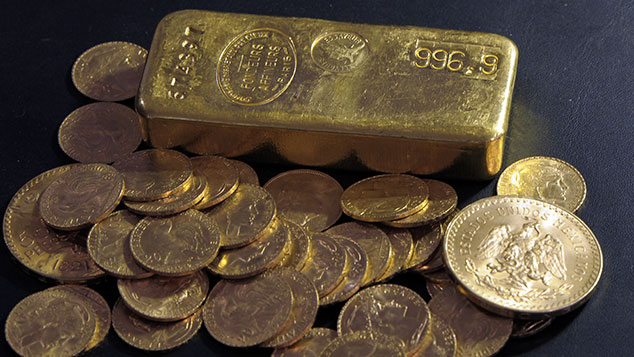
Last year, gold put in what would have been judged a pretty decent performance by the standards of most other years.
In US dollar terms it rose by 13%. That was its best showing since 2010.
And yet, no one cared – for two main reasons.
Firstly, other stuff did better. Secondly, people are still sulking with gold.
But yesterday gold did something unexpected. And it makes me wonder if the mood is turning.
Investors are still wary of gold
Investors have been distinctly unenthusiastic about gold in recent years.
Firstly, it’s been outperformed by rival assets. Obviously, there’s bitcoin. There is a die-hard group of “goldbugs” who don’t like the cryptocurrency with its pretensions to “digital gold” status at all. But there’s also a faction who have transferred all of their hard money affections to the hot new thing. So gold just doesn’t have the following that it once did.
Then there were plain old stocks. It’s one thing to make 13% from gold. But when you could have made the same or more, plus dividend yields, by investing in companies, it just doesn’t seem that exciting.
On a second, more important point, the psychology around gold is at a different phase to that around stocks. Shares collapsed in 2008 and started to recover in 2009. The resulting sense of distrust and wariness has only really faded in the last year or so, to be replaced with the “Oh Lord! What have I missed out on?” mania we’ve seen in the last couple of months.
Gold, on the other hand, fell in 2008 along with everything else, but unlike stocks, that was a blip. It recovered fast, and its bull market lasted until 2011.
The story behind it was simple and its believers enjoyed a sense of moral purity captured by few other investments. Gold was going to be the only remnant of civilisation left (other than cockroaches and tins of spam) when the eurozone finally collapsed, taking what was left of the corrupt global financial system with it.
Society – with its unmanageable debts, buy-now, pay-later culture, and crony capitalist ways – would forsake its credit-based financial system for the honesty of the gold standard.
In short, if gold was a comic book hero, it would have been Rorschach.
Yet in September 2011, it reached its all-time peak price (of around $1,900 an ounce), and then slowly but surely gave up the ghost. Instead of saving the capital of the righteous, it destroyed it.
That sort of betrayal is not easy to forget or to forgive, even if it does come from an inanimate object. As a result, gold is still very much in “once bitten, twice shy” territory for a lot of investors.
The US Treasury Secretary buries the US dollar
So what was significant about yesterday? The main shift is that gold managed to claw its way above its highest point reached in 2017. That may be meaningful and it may not.
But if you’re a fan of technical analysis, it means that gold has challenged a key area of resistance. In other words, it’s managed to get back up to an area where – in the past – it has often ended up being sold. That suggests that sentiment is changing.
The catalyst for this particular rally for gold was US dollar weakness. US Treasury Secretary Steve Mnuchin basically came out at Davos and said that he’s pretty relaxed about the idea of a weaker dollar. This has been true of the average US Treasury Secretary throughout much of modern history, but the key is that they don’t usually admit it.
Yet, according to Deborah Ball at The Wall Street Journal, Mnuchin said: “A weaker dollar is good for trade. In the longer term, a stronger dollar is a reflection of the strength of the US economy.”
As Marc Chandler of Brown Brothers Harriman told the FT: “While Mnuchin was only stating the obvious, Treasury secretaries since Robert Rubin have never really deviated from the strong dollar mantra”. The absence of this “strong dollar” mantra means markets automatically assume that the US would prefer “a weaker dollar”. Which in turn, is a green light to sell the US currency.
However, it’s not just about the weak dollar. It’s also about a growing sense that we’re in the “late-cycle” inflationary bit of the investment merry-go-round. As Dave Rosenberg of Gluskin Sheff points out, during that sort of period, “gold and oil are the top performers within the commodity group”.
How to invest in a gold rally
If you want to get exposure to the gold price, there are various exchange-traded funds (ETFs) that do the job, or you can buy physical gold online or even in person at a bullion dealer.
At MoneyWeek we feel that at least a small proportion of your portfolio should be in physical gold, primarily as an insurance play (it’s a good diversifier in that when things go pear-shaped, gold is one of the few things that tends to go up).
But if you’re looking for a more aggressive play on the gold rally – in other words, we’re not talking insurance, we’re talking a bet on gold continuing to rise – you could invest in the gold mining sector. Indeed, that was my tip for 2018 in our recent forecasts issue of MoneyWeek magazine (if you’re not already a subscriber, get your first four issues free here).
For example, the gold producers index in Australia hit its highest level since November 2016 yesterday, notes the FT. Gold miners might not be keen on a weaker dollar, nor on higher oil prices and inflation (they drive up production costs). But following a pretty brutal bear market, miners are more disciplined.
It’s inevitable that at some point they will lose this discipline all over again – but if the gold price keeps rising, then in the meantime, there could be a solid period of rebounding profitability to buoy their stocks nicely.